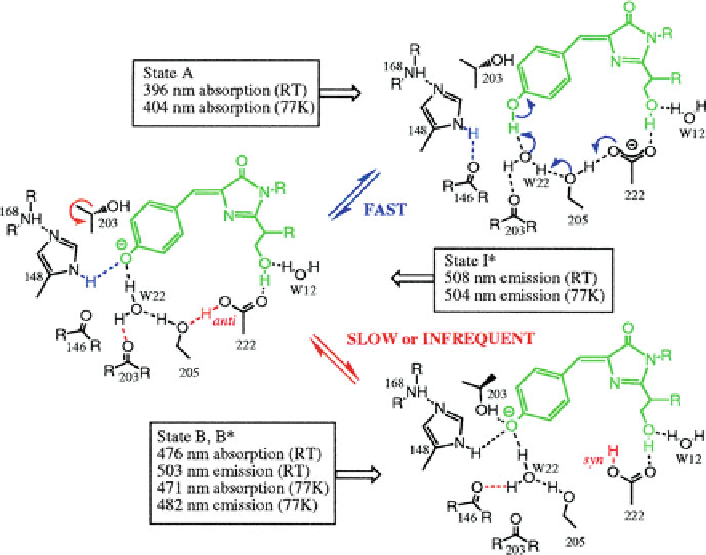Biology Reference
In-Depth Information
transfer coordinate. The size of the very large Stokes shift, as an energy term, is
taken as an approximation for the loss of proton affinity in the excited state, minus
relaxation in the Frank Condon regions [
17
,
18
]. The resulting drop of the pKa of
the chromophore with optical excitation drives the ultrafast, picosecond timescale,
ESPT reaction.
The ESPT reaction and the details of the fluorescence photocycle are not the
focus of this review and will be discussed elsewhere in this volume by Steve Meech.
However, the photoconversion reaction competes with the dominant fluorescence
photocycle, and its properties must therefore be mentioned in the light of the
essential characteristics of the fluorescence photocycle. Specifically, the charge
transfer and structural response of both reactions will be discussed in this chapter.
Furthermore, mechanisms for photoconversion that were proposed in the litera-
ture are intricately linked with the fluorescence photocycle and the ESPT that
occurs during it. Specifically, Sixma and co-workers proposed structural mechan-
isms for both the ESPT reaction in the fluorescence photocycle and one for the
photoconversion reaction [
5
] (Fig.
4
). A similar scheme was also proposed by Palm
Fig. 4 Proposed mechanism for excited state proton transfer (
blue
) and photoconversion (
red
)in
GFP made on the basis of X-ray structural analysis by Sixma and co-workers. Reproduced with
permission from [
5
]. All available evidence agrees with the molecular mechanism proposed for
ESPT (
blue
), as summarised here. However, the proposed syn-anti isomerisation of protonated
Glutamic acid (
red
) was shown not to be the basis of photoconversion reaction [
19
,
20
], but has
since been invoked in the fluorescence photocycle of GFP instead [
21
-
23
]

Search WWH ::

Custom Search